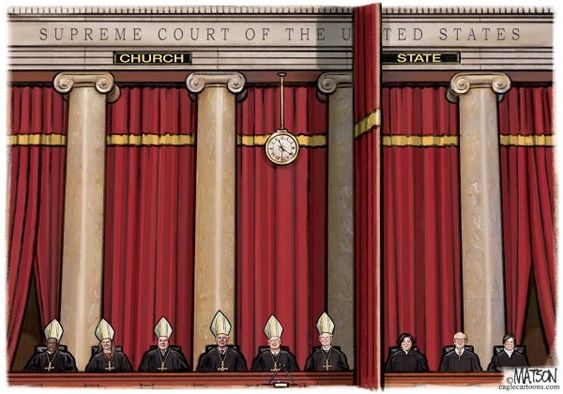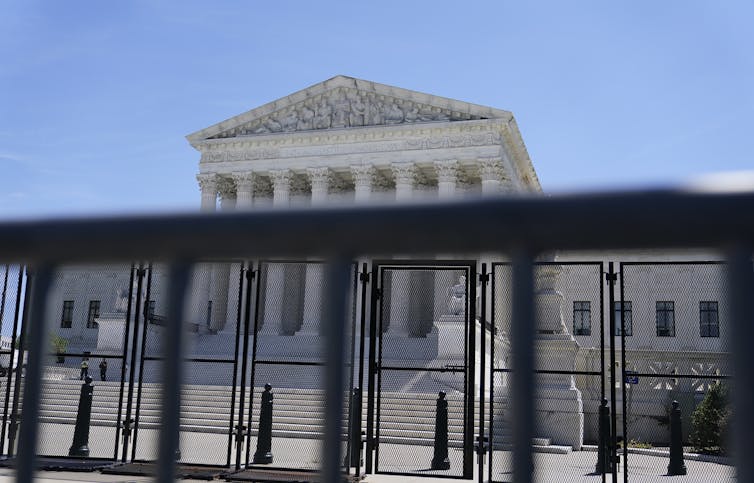

(AP Photo/Mariam Zuhaib)
Matthew Lebo, Western University, and Ellen Key, Appalachian State University
When United States Supreme Court Justice Antonin Scalia died with 10 months left in President Barack Obama’s second term, Mitch McConnell, the Senate majority leader at the time, took the extreme step of refusing to hold hearings for his nominated replacement, Merrick Garland.
McConnell hoped that a Republican might soon win the presidency and choose a different nominee. He got his wish.
Despite getting three million fewer votes than Hillary Clinton, Donald Trump won the presidency that November. Now, 18 months since his presidency ended, Trump’s impact on American life has probably never been more substantial as the Supreme Court he reshaped has pushed America in a sharply conservative direction.
Crumbling democratic norms
In fact, five out of the nine justices on the court this term were appointed by men who became president while losing the popular vote. Trump managed to appoint a third of the court during his four years in office, compared to Obama’s two appointments in eight years.
The combination of crumbling democratic norms in the appointments process and an ideological court out of step with mainstream America raises questions of how the Supreme Court could be reformed.
These lifetime appointees have now jolted America on guns, Christian prayer in public schools, racial gerrymandering of electoral districts and abortion rights. The conservative pivot shows no signs of stopping.
In his concurrence in the case that overthrew Roe v. Wade, Justice Clarence Thomas also urged a re-examination of same-sex marriage, sodomy laws and contraceptive use. The court will rule on affirmative action next term.
With confidence in the U.S. Supreme Court at an all-time low, many want something done to check the court’s influence.

(AP Photo/Mary Altaffer)
Suggestions for reform
The U.S. Constitution gives Congress power over the size and structure of the judicial branch. Justices serve for life, barring impeachment, making removal difficult. Altering the size of the court, however, can be done by statute.
The constitution does not say there must be nine justices on the Supreme Court. In fact, there has been considerable variation in the number of justices over the course of American history — between five and 10 justices comprised the court before Congress settled on nine in 1869.

(AP Photo/Pablo Martinez Monsivais)
Many of these changes were undertaken for political reasons, and talk of changing the size of the court continued. Republicans’ refusal to consider Garland’s nomination reinvigorated interest in expanding it. In 2021, President Joe Biden created a commission to evaluate a variety of reforms.
Court-packing — expanding the size of the Supreme Court for purposes that could be viewed as partisan — is not the only reform option available. Introducing term limits would bring the Supreme Court in line with most of the world’s high courts.
Other structural reform proposals include having subsets of justices hear each case or establishing a system where judges rotate between the Supreme Court and lower federal courts. Others aim for ideological balance by creating a set number of seats for Democratic and Republican nominees.
Some ideas are easier to implement than others. While expanding the size of the U.S. Supreme Court can be done by passing a law, other proposals require constitutional change. The difficult process of amending the U.S. Constitution makes statutory reforms that much more attractive.
Changes would require Democratic House and Senate majorities in favour of a new law as well as a majority of senators willing to set aside the filibuster to pass it. The Democrats are short several votes on eliminating the filibuster, but the court’s recent decisions might help them make gains in this fall’s mid-term elections.
Ideologically motivated
Why does the court’s size matter? When justices are neutral umpires calling balls and strikes, their number is not so important.
But when decisions are seen as ideologically motivated, judicial legitimacy — the key tool the court has to enforce its decisions — is threatened. Restoring ideological balance to the Supreme Court is a means to preserve its institutional legitimacy.
Can the court change direction? Biden expressed concern that court-packing could backfire by making it even more politicized. However, reforms that bring Supreme Court decisions in line with public opinion should increase legitimacy of what used to be the most trusted branch of American government.

(AP Photo/J. Scott Applewhite)
Even if the court is expanded, the nomination process for justices has become open warfare between the Democrats and Republicans. With mid-term elections ahead, McConnell has indicated that, if Republicans win a majority in the Senate, they would treat a nomination from Biden in 2023 or 2024 as they did Obama’s in 2016, keeping a seat vacant in the hopes of a new Republican president.
An ominous future
Democracy rests in large part on the perception that political institutions are doing their jobs fairly and for the common welfare.
There have been periods of American history where one branch of government has sunk beneath the others in their perceived legitimacy. But with ratings of Congress and the president so low, having the legitimacy of the Supreme Court sink as well brings faith in the overall system to dangerously low levels.
Among other worries, if a court that most view as biased is called upon to decide the 2024 presidential election, the remaining pieces of American democracy could crumble fast.![]()
Matthew Lebo, Professor and Chair, Department of Political Science, Western University and Ellen Key, Professor, Department of Government and Justice Studies, Appalachian State University
This article is republished from The Conversation under a Creative Commons license. Read the original article.




3 Comments
Pingback: Patong boxing stadium
Pingback: blote tieten
Pingback: som777